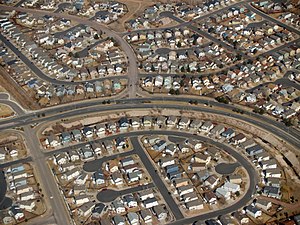This article has multiple issues. Please help improve it or discuss these issues on the talk page. (Learn how and when to remove these messages)
|

Suburbanization (American English), also spelled suburbanisation (British English), is a population shift from historic core cities or rural areas into suburbs. Most suburbs are built in a formation of (sub)urban sprawl.[1] As a consequence of the movement of households and businesses away from city centers, low-density, peripheral urban areas grow.[2] Proponents of curbing suburbanization argue that sprawl leads to urban decay and a concentration of lower-income residents in the inner city,[3] in addition to environmental harm.
Suburbanization can be a progressive process, as growing population pushes outward the zones of the concentric zone model that move outward to escape the increasing density of inward areas. For example, Kings County, New York served New York City as farmland in the 18th century, with boats carrying produce across the East River. The steam ferry later made Brooklyn Heights a commuter town for Wall Street. Streetcar suburbs spread through the county, and as elevated railways further extended its reach, the City of Brooklyn grew to fill the county. Areas along the river became industrialized and apartment buildings filled the places where factories did not replace the scattered houses. As a result, much of Brooklyn transformed into a suburban economy and later into an urban economy entirely. Many other suburbs have followed this same cycle.
- ^ "Urban Areas". National geographic. Retrieved December 22, 2023.
- ^ Caves, R. W. (2004). Encyclopedia of the City. Routledge. p. 642. ISBN 9780415252256.
- ^ "Slow Growth and Urban Sprawl: Support for a New Regional Agenda?", Juliet F. Gainsborough, Urban Affairs Review, vol. 37, no. 5 (2002): 728–744.